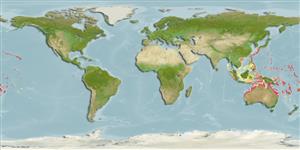Common names from other countries
Classification / Names / Names
Common names | Synonyms | Catalog of Fishes (gen., sp.) | ITIS | CoL | WoRMS
Environment: milieu / climate zone / depth range / distribution range
Ecology
Reef-associated; depth range 0 - 30 m (Ref. 848). Tropical; 36°N - 31°S, 81°E - 153°W (Ref. 848)
Indo-West Pacific: Japan to Australia and Sri Lanka to Hawaii.
Length at first maturity / Size / Weight / Age
Maturity: Lm ? range ? - ? cm
Life cycle and mating behavior
Maturity | Reproduction | Spawning | Eggs | Fecundity | Larvae
Members of the class Anthozoa are either gonochoric or hermaphroditic. Mature gametes are shed into the coelenteron and spawned through the mouth. Life cycle: The zygote develops into a planktonic planula larva. Metamorphosis begins with early morphogenesis of tentacles, septa and pharynx before larval settlement on the aboral end.
Veron, J.E.N. 2000. (Ref. 848)
IUCN Red List Status (Ref. 130435: Version 2024-1)
CITES status (Ref. 108899)
Not Evaluated
Human uses
| FishSource |
Tools
More information
Age/Size
Growth
Length-weight
Length-length
Morphology
Larvae
Abundance
Internet sources
Estimates based on models
Preferred temperature
(Ref.
115969): 24.2 - 29.4, mean 27.7 (based on 1003 cells).
Price category
Unknown.
